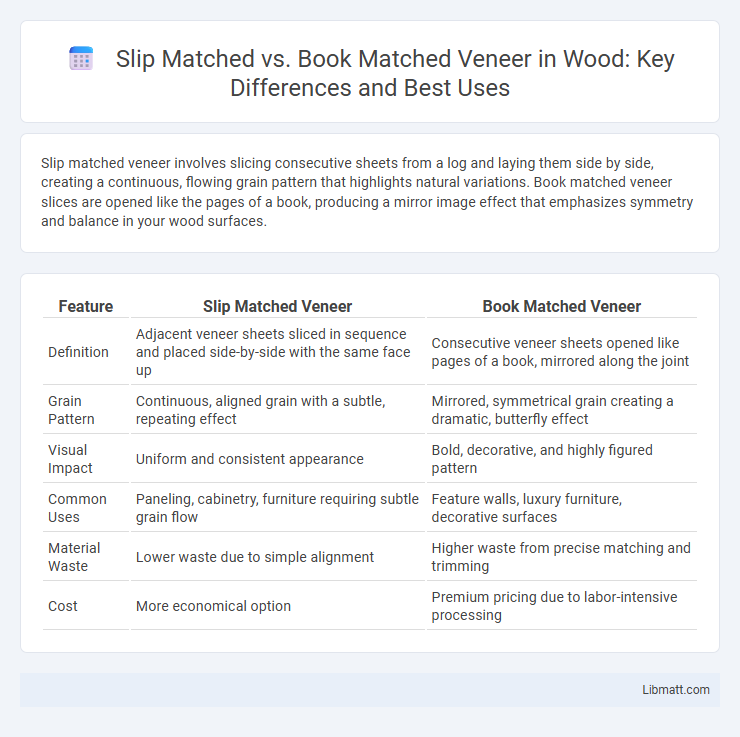Slip matched veneer involves slicing consecutive sheets from a log and laying them side by side, creating a continuous, flowing grain pattern that highlights natural variations. Book matched veneer slices are opened like the pages of a book, producing a mirror image effect that emphasizes symmetry and balance in your wood surfaces.
Table of Comparison
| Feature | Slip Matched Veneer | Book Matched Veneer |
|---|---|---|
| Definition | Adjacent veneer sheets sliced in sequence and placed side-by-side with the same face up | Consecutive veneer sheets opened like pages of a book, mirrored along the joint |
| Grain Pattern | Continuous, aligned grain with a subtle, repeating effect | Mirrored, symmetrical grain creating a dramatic, butterfly effect |
| Visual Impact | Uniform and consistent appearance | Bold, decorative, and highly figured pattern |
| Common Uses | Paneling, cabinetry, furniture requiring subtle grain flow | Feature walls, luxury furniture, decorative surfaces |
| Material Waste | Lower waste due to simple alignment | Higher waste from precise matching and trimming |
| Cost | More economical option | Premium pricing due to labor-intensive processing |
Introduction to Veneer Matching Techniques
Slip matched veneer involves slicing consecutive sheets from a log and applying them side by side in the same orientation, producing a natural, flowing grain pattern with slight color and texture variations. Book matched veneer requires flipping every other veneer sheet like pages of a book, creating a mirrored, symmetrical design that highlights contrast and balance in wood grain. Your choice between slip matched and book matched veneer influences the aesthetic appeal and visual rhythm of surfaces such as cabinetry, paneling, and furniture.
What is Slip Matching in Veneer?
Slip matching in veneer refers to the process of slicing consecutive sheets of veneer from a log and placing them side by side without flipping, creating a natural, continuous grain pattern that flows in one direction. This method preserves the organic look of the wood, showcasing the unique growth characteristics and color variations found in each sheet. Understanding the difference between slip matched and book matched veneer helps you select the best aesthetic for your woodworking project.
What is Book Matching in Veneer?
Book matching in veneer involves slicing a single wood log into consecutive thin sheets and opening them like pages of a book to create mirrored patterns. This technique enhances the visual appeal by producing symmetrical designs that emphasize natural grain continuity. Book matched veneers are commonly used in high-end furniture and interior decor to achieve elegant and cohesive aesthetics.
Visual Differences: Slip Matched vs Book Matched Veneer
Slip matched veneer displays a continuous grain pattern with a subtle, flowing appearance as adjacent sheets are sliced sequentially from the same log but not flipped. Book matched veneer reveals mirror-image symmetry with alternating sheets flipped like pages in a book, creating bold, mirrored patterns that emphasize contrast and balance. The visual difference lies in slip matched's seamless linear flow versus book matched's striking, symmetrical design.
Aesthetic Impact on Interior Design
Slip matched veneer creates a flowing, continuous grain pattern that enhances the natural, organic feel of interior surfaces, ideal for modern and minimalist spaces. Book matched veneer offers symmetrical, mirror-image patterns that add visual balance and sophistication, making it perfect for feature walls and high-end cabinetry. Your choice between these techniques will significantly influence the ambiance and style coherence of your interior design project.
Advantages of Slip Matched Veneer
Slip matched veneer offers a seamless and natural grain flow by slicing consecutive leaves in order, creating a uniform appearance ideal for large panels. This method maximizes material usage and reduces waste compared to book matched veneer, providing cost efficiency and sustainability benefits. Slip matched veneer is preferred for modern designs seeking subtle, consistent patterns without the mirror effect characteristic of book matching.
Advantages of Book Matched Veneer
Book matched veneer offers a visually striking, symmetrical pattern that enhances the aesthetic appeal of surfaces such as furniture and cabinetry. This veneer type maximizes material utilization by slicing consecutive sheets from the same log, ensuring consistent grain alignment and color variation. Your projects benefit from a refined, balanced look that highlights natural wood beauty and adds value to high-end interior designs.
Common Applications for Each Matching Method
Slip matched veneer is commonly used in large furniture panels, wall panels, and cabinetry where a natural, flowing grain pattern enhances visual appeal and provides a seamless look across wide surfaces. Book matched veneer is often preferred for high-end applications such as decorative paneling, luxury furniture, and architectural millwork, where symmetrical grain patterns create a striking, mirror-image effect that highlights craftsmanship. Your choice depends on whether you prioritize a continuous grain flow with slip matching or a bold, mirrored aesthetic offered by book matching.
How to Choose Between Slip and Book Matching
Choosing between slip matched and book matched veneer depends on the desired visual effect and grain flow continuity. Slip matched veneer offers a uniform grain pattern with repeated sheets side by side, ideal for a consistent look in cabinetry or paneling. Book matched veneer creates a mirror image effect by flipping adjacent sheets, enhancing visual symmetry and elegance for feature walls or high-end furniture.
Conclusion: Selecting the Right Veneer Matching Style
Choosing between slip matched and book matched veneer depends on your design goals and aesthetic preferences. Slip matched veneers offer a continuous grain flow with subtle variation, ideal for a natural, understated look, while book matched veneers produce a mirrored, symmetrical pattern that creates striking visual impact. Understanding your project's style and the desired effect will help you select the perfect veneer matching style to enhance your surfaces effectively.
Slip matched vs book matched veneer Infographic

 libmatt.com
libmatt.com